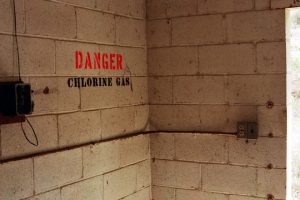A number of public health officials are pushing for the Environmental Protection Agency to put asbestos at the top of their list of regulatory priorities. However, Bloomberg reports those in the pool chemical industry are concerned about this. That’s because chlorine, caustic soda and other chemicals manufactured in this industry use asbestos. In fact, the U.S. Geological Survey lists the chlor-alkali industry as the No. 1 importer of asbestos in its yearly mineral commodity summary. The chlorine industry’s use of asbestos accounts for 90 percent of the 358 tons of asbestos imported into the country last year, according to the survey’s most recent report.
While many people think of asbestos as a man-made product, it is actually a naturally occurring substance made up of a combination of silica elements. It forms in the ground like other minerals and has been used by humans for thousands of years.
 However, it was during the 1800s in the industrial revolution that it became heavily used, and, by the 1970s, when the asbestos ban went into effect, asbestos was used in just about every residential, commercial, and industrial construction project in much of the world. There are various reasons that asbestos was used so heavily.Originally, asbestos was used because of its natural ability to resist heat, fire, caustic chemicals, and even electricity. It was used for insulation and as fireproofing material. It was also used to make things like fire blankets that were to be thrown on fire to extinguish it. These blankets were not going to burn and could smother a fire. They were, however, very dangerous to handle and were likely to give off asbestos dust when exposed to a fire, even though they didn’t burn up completely.
However, it was during the 1800s in the industrial revolution that it became heavily used, and, by the 1970s, when the asbestos ban went into effect, asbestos was used in just about every residential, commercial, and industrial construction project in much of the world. There are various reasons that asbestos was used so heavily.Originally, asbestos was used because of its natural ability to resist heat, fire, caustic chemicals, and even electricity. It was used for insulation and as fireproofing material. It was also used to make things like fire blankets that were to be thrown on fire to extinguish it. These blankets were not going to burn and could smother a fire. They were, however, very dangerous to handle and were likely to give off asbestos dust when exposed to a fire, even though they didn’t burn up completely.
In later years, manufacturers discovered that the chemical structure of asbestos made it ideally suited to work as a binding agent. This meant it could be used to bind cement, glue, plaster, and other joinery compounds useful to construction projects. It was also fire retardant, and that served as an added bonus. The obvious downside was that it was killing workers who handled it, but as our Boston mesothelioma attorneys can explain, it typically takes between 20 and 50 years for people to become noticeably sick, so companies did all they could to hide that risk from the workers and the general public, because they were making huge profits with asbestos.
While asbestos was banned in the late 1970s, the United States Supreme Court quickly overturned that ban, and various companies and importers have used asbestos since that time for limited uses that are legal. There has been a recent push by the president to get Congress and the (EPA) to put asbestos on the top of their list of banned toxic substances.
However, according to a recent news feature from Chem Info, the pool chemicals industry and other chlorine producers are worried this could seriously harm their businesses. The reason for this is because asbestos is used in the process of making chlor-alkali products such as the chlorine in pool chemicals. Asbestos is also used to make a chemical known as caustic soda.
The process was developed in the late 1800s and involves the use of asbestos to separate a cathode and an anode applied to sodium hydroxide, and the result is chlorine. There was also a related discovery that was contemplated as a weapon of war (thankfully never used) that created a chemical known as chlorine triflouride that can burn most substances on contact, including glass and even asbestos.
Results of the EPA’s review should be released in the next several months.
If you or a loved one is diagnosed with mesothelioma in Boston, call for a free and confidential appointment at (617) 777-7777.
Additional Resources:
Why Tighter Asbestos Restrictions Could be Bad News For Chlorine Producers, September 16, 2016, By Andy Sal, Chem Info
More Blog Entries:
New Effort to Strengthen Asbestos Litigation, June 28, 2016, Boston Mesothelioma Lawyer Blog
 Mesothelioma Lawyers Blog
Mesothelioma Lawyers Blog

